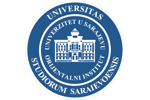Religious Structure of Bosnia’s Population in the First Centuries of the Ottoman Rule
Abstract
This is a review of the religious structure of the population as no other differences were manifested at that time, nor in the Middle Ages. In official Ottoman censuses ali the inhabitants of all social classes were registered only as "Bosnians" who spoke the Bosnian language. This makes it clear that the Ottoman authority recognized that the Slavio people were specific aithough by setting up towns it tried to develop its own culture and strengthen its powering that territory.
The followers of the teaching of the so-called "Church of Bosnia", which spread here from the beginning of the 13th century until the mid-15th century and was condemned as heresy, suffered brutal persecution by the Catholic Church. The struggle was waged by the Franciscans. They built their first church in 1340, and by the middle of the 15th century they had built 13 Catholic churches in Central and north-eastem Bosnia (Fojnica, Kreševo, Sutjeska, Visoko, Vranduk, then Srebrenica, Zvomik, Olovo, Bijeljina, Gornja Tuzla, Donja Tuzla, Modriča and Tešanj).
So the Ottoman authorities found (1463) few followers of the "Church of Bosnia" in Bosnia. According to some scientists, its teaching never abandoned the scope of Christian orthodoxy, but it only represented particular Christian teaching in the local language. It was more a manifestation of rebellion against social injustice than it was a separate religion. It resisted both Byzantinization and Latinization of the South-Slavic countries. Particularly brutal mass persecutions of the "Christians" (krstjani), as they called themselves, took place in the last decade of the Bosnian State’s existence. Obviously those were the reasons why Sultan Mehmed II had an unexpected meeting with a congregation near Jajce when a larger group of people expressed their subservience to him. Moreover, they adopted Islam.
The spread of Islam in Bosnia had a specific course. It was considerably faster and more intensive than in other areas. Reasons for that have not yet been sufficiently investigated. The time coincidence between the disappearance of the "Church of Bosnia" and the spread of Islam has been taken as the most powerful evidence that the population was autochthonous regardless of whether it was found as Bogomil (cryptobogomil), or as Catholic. Most of them converted into Islam. Such a process was mostly a result of persecution of the Christians (krstjani). Islam spread most in the centers of power, i.e. in the Bosnian Sanjak (from Novi Pazar to Bihać). Owing to the existence of numerous urban settlements Muslims in total population in 1604 amounted to 71%, while ali the other inhabitants made up 21%. In other sanjaks of the Ejalet (Pashadom) of Bosnia (Zvomik, Herzegovina and Klis), the percentage of Muslims was lower.
Although only Catholic churches were found in Bosnia, with only two Orthodox ones in Herzegovina around Trebinje, there is evidence that in Podrinje (The Drina River basin) the Catholic and Orthodox population lived together even before the Turks. Although the same Islamic regulations were in effect for all the Christians, the Catholic population was in a more difficult position. It was probably so because the Pope had organized Christian countries against the Turks in contrast to the Patriarch who resided near the Sultan. With the spread of Islam, Catholic churches, which were usually in towns, disappeared gradually. That population was pushed out from important strategic points and from around fortified towns both by the authority and by the Orthodox Wallachians. In their place the Orthodox population settied. The Orthodox population mostly settled in Bosnia only after the establishment of the Ottoman rule. They came from Monte Negro and Herzegovina as Wallachians - cattlebreeders - and they were organized in districts (knežine). After these movements of population Orthodox monasteries were built. So from the middle of the 16th century until the middle of the 17th century, six monasteries were built in north-eastem and Central Bosnia (Paprača, Lomnica, Tamna, Ozren, Vozuća and Udrim- Gostović). The population had the strong support of its district organization and of its economically stronger church organization. The spread of Islam was considerably less intensive among these people than among other farming peoples.
Finally, a few words should be said about Jews. Between 1492 and 1497 Sultan Bayazid (1481-1512) allowed the Jews expelled from Spain and Portugal to settle in the lands of the Ottoman Empire. They were classified into westem Jews called Sephardim and eastern Jews called Ashkenazim. In Bosnia the Sephardim settled in greater numbers.



